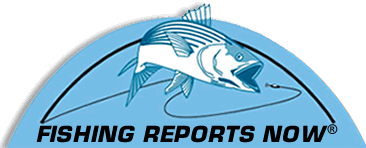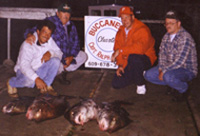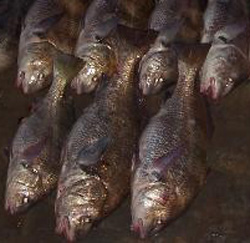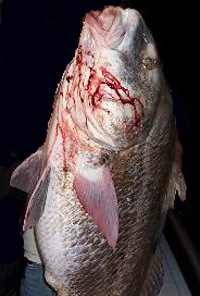The Bay Behemoth |
||
|
Why do you fish? Black drum fishing, on Delaware Bay, has got most of that. It's got the fight. It's got the experience. Bobble-y-bob, up-and-down, beyond the sight of land. Behemoth is. The word behemoth was The description fits. The rows of scales on its back are so joined together, they can’t be parted. |
|
Ralph started chartering for drum in 1961, when almost nobody else from the fleet sailed for them, he said. To understand Ralph's approach to drum fishing, the first thing to know, he said, is that he runs 10-hour trips for them. He wants to fish two tides, though many only fish one.
It’s like deer hunting, he said. He anchors at a likely place where other anglers have been catching them lately. Nobody knows exactly when they’ll come on a given day, but if the fish have been swimming the area lately, they’ll probably arrive sometime. The drum are feeding, grubbing clams, crabs and other bottom bait. You’ll hear them arriving, Ralph said, because they’ll keep booming to communicate with each other The only time he might move from his original spot is when others let him know they're catching lots. The Buccaneer’s drum charters begin at 1 p.m. Fishing for drum at dusk into darkness is popular, but that’s not because drum only bite during low-light hours. Some say that small drum swim into the bay first during the season. When drum leave the bay, many swim offshore and live at the canyons on the Continental Shelf, Ralph said. Ralph’s anglers fish for drum with a large surf clam on a tandem-hooked rig to hold lots of bait. Two clams might be used, or a clam and a shedder crab might be. These are sorts of baits that drum are known to forage on. The rig is a fish-finder or a sinker-slide. The hooks are Gamakatsu sizes 9 or 10 non-offset, non-circle hooks. But that’s just Ralph’s preference, and he says many types of hooks can be used, including offsets and circles.
The Buccaneer’s anglers fish with 50-pound line on 4500 or 6500 Shimano Baitrunner spinning reels. That’s heavy line, and the purpose is for the anglers not to lose fish. But private anglers can use lighter outfits, 30- or 40-pound line, for sport. Ralph uses spinning reels because many charters enjoy spinning tackle more than conventional. But anglers Medium to heavy, 6-foot Ugly Stick rods are used on the Buccaneer. On the Buccanneer, anglers hold the rod instead of placing it in one of the rod holders while fishing. That can be a long time to hold a rod, but the fish, though giants, bite lightly. Anglers are likely to miss bites if not holding the rod to feel them. When a bite is felt, the angler waits a moment until the line comes tight, then sets the hook Landing any large fish is a challenge. The crew on the Buccaneer teaches anglers during the fight to remain calm, let the fish run, let it take line when it wants. The angler should patiently pump and reel when the fish allows. Then fight will be won without wearing down the angler. Drum typically begin biting either near Bug Light or the nearby sloughs on the New Jersey side of the bay or at Slaughter Beach on the Delaware side. During last year Ralph’s drum fishing finished for the season around Miah Maul Lighthouse. But the general areas where drum appear throughout the season is unpredictable, and changes year to year. It can also change during the season itself. Striped bass are often mixed in. Big, spawning, “tiderunner” weakfish, like 14-pounders, used to be. But the tiderunners were scarce in recent years. Some people eat drum, and some let them go. No need to explain catching them without eating. Who dares stand before him? the Book of Job asks about the behemoth. Delaware Bay anglers -- the ones who seek the ultimate sport and art |
||



 Ralph, in his years of fishing
Ralph, in his years of fishing  The tandem hooks are tied on an 80-pound fluorocarbon leader. Some anglers use 100-pound leaders.
The tandem hooks are tied on an 80-pound fluorocarbon leader. Some anglers use 100-pound leaders.